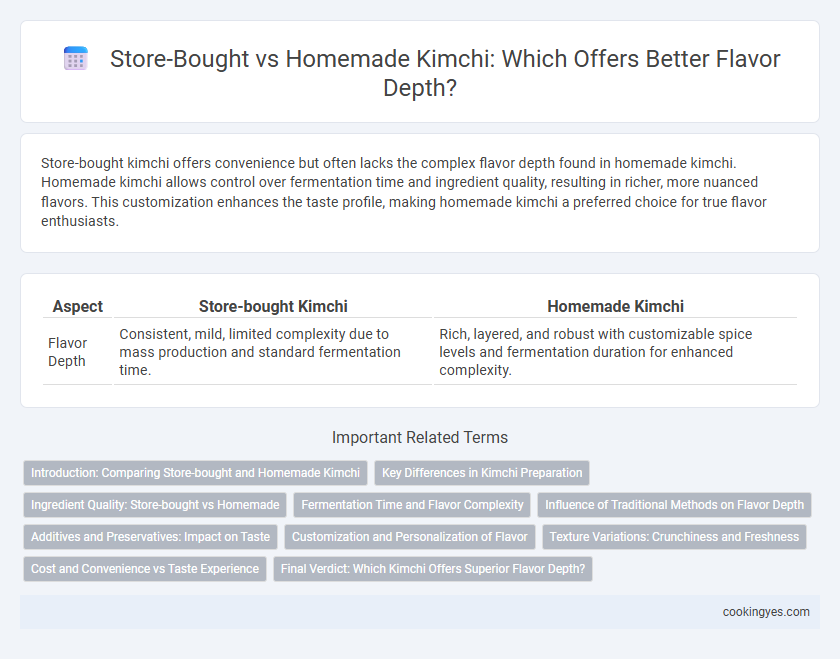Store-bought kimchi offers convenience but often lacks the complex flavor depth found in homemade kimchi. Homemade kimchi allows control over fermentation time and ingredient quality, resulting in richer, more nuanced flavors. This customization enhances the taste profile, making homemade kimchi a preferred choice for true flavor enthusiasts.
Table of Comparison
| Aspect | Store-bought Kimchi | Homemade Kimchi |
|---|---|---|
| Flavor Depth | Consistent, mild, limited complexity due to mass production and standard fermentation time. | Rich, layered, and robust with customizable spice levels and fermentation duration for enhanced complexity. |
Introduction: Comparing Store-bought and Homemade Kimchi
Store-bought kimchi often provides consistent flavor profiles due to standardized fermentation processes and controlled ingredient quality. Homemade kimchi offers deeper complexity and unique flavor nuances influenced by personalized fermentation times, regional ingredients, and traditional recipes. Flavor depth in homemade kimchi typically intensifies with longer fermentation, creating richer umami and tangy notes compared to the milder, ready-to-eat taste of store-bought varieties.
Key Differences in Kimchi Preparation
Store-bought kimchi often uses standardized fermentation processes and preservatives, resulting in a consistent but less complex flavor profile compared to homemade kimchi. Homemade kimchi allows for personalized adjustments in ingredients like garlic, ginger, and chili flakes, enhancing depth and umami richness through varied fermentation times. The key difference lies in freshness and ingredient control, where homemade versions typically develop a more robust and layered taste due to natural fermentation and absence of additives.
Ingredient Quality: Store-bought vs Homemade
Store-bought kimchi typically relies on standardized ingredients and preservatives to ensure shelf stability, which can limit the complexity and depth of flavor. Homemade kimchi allows for the use of fresh, high-quality Napa cabbage, Korean chili flakes (gochugaru), and natural fermentation processes that enhance umami and create richer, more vibrant taste layers. Ingredient quality in homemade kimchi directly influences the fermentation intensity and unique flavor profiles, making it superior to many commercial alternatives.
Fermentation Time and Flavor Complexity
Store-bought kimchi typically undergoes shorter fermentation periods, resulting in milder flavor profiles with consistent but less complex taste. Homemade kimchi benefits from extended fermentation times tailored by the maker, allowing deeper flavor development and richer umami complexity. Variations in temperature and ingredient freshness during home fermentation further enhance the layers of sourness, spiciness, and fermentation-derived nuances compared to mass-produced alternatives.
Influence of Traditional Methods on Flavor Depth
Traditional methods of fermenting kimchi, such as using natural sea salt and aging in earthenware pots, enhance the development of complex, deep flavors that are often missing in store-bought varieties. Homemade kimchi allows for precise control over fermentation time and ingredient quality, resulting in rich umami and balanced sourness. Store-bought kimchi typically undergoes faster, industrial-scale fermentation processes that can limit flavor depth and uniqueness.
Additives and Preservatives: Impact on Taste
Store-bought kimchi often contains additives and preservatives such as sodium benzoate and artificial flavor enhancers that can diminish the natural umami and complexity of fermented flavors. Homemade kimchi relies on natural fermentation, allowing the development of richer, deeper taste profiles from organic ingredients like fresh napa cabbage, garlic, and chili flakes. The absence of chemical preservatives in homemade kimchi preserves the authentic sourness and layered spice intensity, offering a more vibrant and robust flavor experience.
Customization and Personalization of Flavor
Store-bought kimchi offers consistent flavor profiles, often tailored for mass appeal, but lacks the nuanced depth achieved through fermentation control. Homemade kimchi allows for personalization by adjusting ingredients such as garlic, chili, and salt levels, creating a unique balance that suits individual taste preferences. The ability to experiment with fermentation duration enhances complexity, resulting in richer, more dynamic flavors that store-bought versions typically cannot replicate.
Texture Variations: Crunchiness and Freshness
Store-bought kimchi often offers consistent crunchiness due to standardized fermentation and controlled packaging processes, preserving a balanced texture ideal for immediate consumption. Homemade kimchi features varied textures, with fresher, more vibrant crunchiness influenced by ingredient freshness and fermentation duration, allowing for personalized texture preferences. The freshness in homemade versions typically enhances the tactile experience, delivering a dynamic contrast between crisp vegetables and tender fermented layers.
Cost and Convenience vs Taste Experience
Store-bought kimchi offers cost-effective convenience with consistent flavor profiles ideal for everyday meals, while homemade kimchi delivers richer, customizable taste depth through traditional fermentation methods. The price difference reflects the time investment and ingredient quality, as homemade versions often use fresher vegetables and tailored spice blends. Home fermentation allows for experimenting with pungency and texture, providing a superior sensory experience compared to the standardized flavors of commercial products.
Final Verdict: Which Kimchi Offers Superior Flavor Depth?
Store-bought kimchi often delivers consistent flavor profiles due to standardized fermentation processes and controlled ingredient quality. Homemade kimchi provides superior flavor depth by allowing customization of fermentation time, seasoning intensity, and fresh, high-quality ingredients that develop complex umami and tangy notes. For connoisseurs seeking rich, multidimensional taste, homemade kimchi generally offers the most robust and nuanced flavor experience.
Store-bought Kimchi vs Homemade Kimchi for Flavor Depth Infographic

 cookingyes.com
cookingyes.com